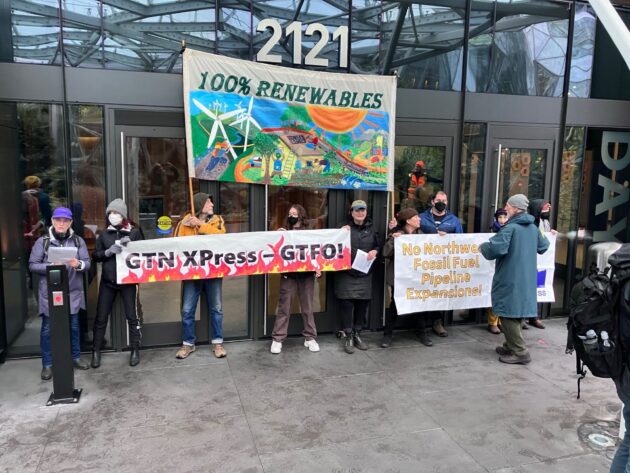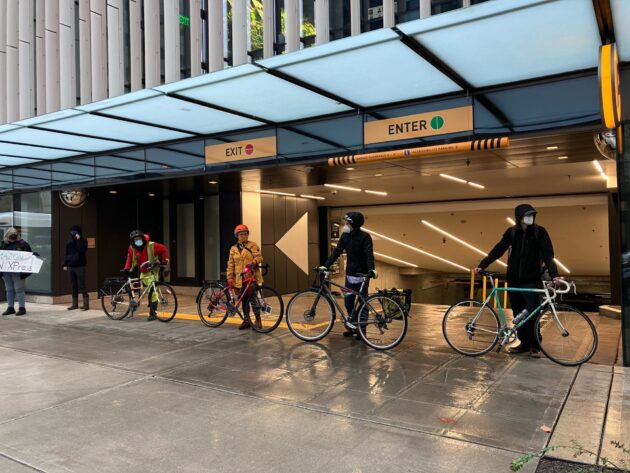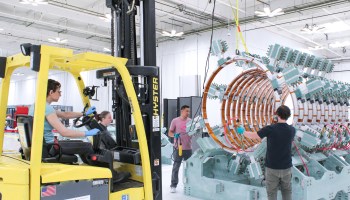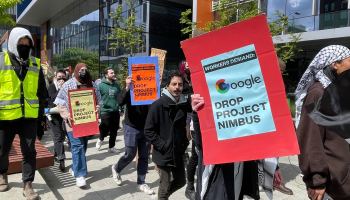
Dozens of environmental activists this morning blocked the entrances at Amazon’s Day 1 building at its Seattle headquarters.
A Washington-based group called the Troublemakers organized the action, calling on the tech giant to cancel its plans to use natural gas from a new pipeline being built in Oregon. The gas would be used to power three data centers in the state.
“The fact that Amazon is still an active participant in a fossil fuel expansion at this moment in time highlights their hypocrisy,” said Emily Johnston, one of the protest organizers.
Amazon has multiple initiatives to address climate change. In 2019, then-CEO Jeff Bezos vowed the company would become carbon neutral by 2040 and created the Climate Pledge — an effort that calls on other corporations to join it in slashing their greenhouse gas emissions. Since that time, the company’s carbon footprint has increased by 39%.
Johnston said about 50-60 people protested at the company Wednesday morning. With banners and bicycles, they blocked doors and garage entrances at the building.
Last week, the Troublemakers sent a letter to Amazon CEO Andy Jassy, asking him to cancel plans to tap into TC Energy’s Gas Transmission Northwest Xpress gas pipeline and use the fuel for its data centers, which house powerful computers that create the backbone for Amazon Web Services (AWS).
“Amazon Web Services is your baby, and by almost any measure, a successful one. Why risk marring Amazon’s reputation (and yours) by locking AWS into decades of fossil gas while also providing justification for the plans for expansion to begin with?” states the letter, which was signed by 19 other organizations, as well, including Amazon Employees for Climate Justice.

Amazon would access the gas through an expansion of the GTN Xpress pipeline. That expansion has drawn opposition from Pacific Northwest leaders including all four U.S. senators representing Washington and Oregon; Oregon Gov. Tina Kotek and Washington Gov. Jay Inslee; and numerous environmental groups.
Oregon news outlets also reported last year on Amazon’s role in lobbying against legislation in the state to create clean energy regulations for data centers. The measure failed.
At the same time, Amazon has taken aggressive actions to address climate issues.
“Amazon is the largest corporate purchaser of renewable energy globally, and that’s been the case for four years in a row. Amazon also co-founded the Climate Pledge, committing to reaching net zero carbon by 2040, and has made incredible progress on its path so far — we match more than 90% of the electricity our operations use with renewable energy, and we’re deploying the world’s largest fleet of electric vehicles with more than 10,000 on the road today,” said Lisa Levandowski, Amazon spokesperson, in an email responding to today’s protest.
Amazon has pledged to use all clean power, a target it says it expects to reach next year — five years ahead of its original timeline.
But how does Amazon hit that goal while also using natural gas? The company’s promise is to buy renewable power in an amount that matches the volume of energy it uses — it doesn’t mean that it’s always getting power from clean sources.
In a GeekWire interview last year, Charley Daitch, AWS director of energy and water strategy, said the company’s use of natural gas in Oregon to power fuel cells was not a permanent solution.
"We’re going to power a very small part of our operations with fuel cells as a short-term bridge. It’s not part of our core strategy. The fuel cells will run on natural gas initially, but we’re actively working at Amazon as a whole to help encourage and facilitate more green hydrogen, which will provide a carbon-free fuel source [and could power the fuel cells]," said Daitch, who is no longer with the company.
"We’ve agreed to do renewable energy projects in Oregon," he added, "but they’re just not available to us yet."
The protesters are not persuaded by the argument.
"Amazon prides itself on innovation. Using fossil fuel is not innovation," they wrote in the letter to Jassy. "It is relying on a dying technology that is killing the planet. The AWS commitment to connect to GTN Xpress is driving a project that would pump more methane into a 50-year-old pipeline, which will certainly increase the methane leaked into the atmosphere."
Microsoft and Google have gone a step further than Amazon in their pursuit of clean energy and are pledging to use renewables 24/7, which means adding power sources that can operate around-the-clock — which wind and solar cannot. Amazon is charting a different course, dubbed “carbon matching,” that prioritizes renewable energy projects in areas with dirtier grids.

While Amazon has focused on wind and solar power, it recently announced plans to buy a Pennsylvania data center that's powered by nuclear energy.
The company has been the target of multiple environmental protests in recent years.
Last summer, a different activist group targeted Amazon's headquarters, spray painting the adjacent roadway with a message addressed to CEO Andy Jassy reading, “AMAZON: PRIME POLLUTER. #DELIVER CHANGE.”
In May of last year, Amazon Employees for Climate Justice helped organize an employee walkout. The group called on Amazon to put climate “at the forefront” of its decision-making, and described the company’s Climate Pledge as “broken, in so many ways.”
Johnston, of the Troublemakers group, said it's important to hold “Amazon and other big polluters accountable."
"We have to shine a light on what they’re doing,” she said.



